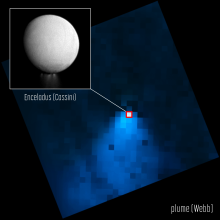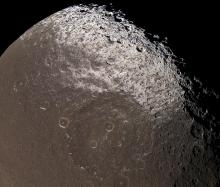Listen to today's episode of StarDate on the web the same day it airs in high-quality streaming audio without any extra ads or announcements. Choose a $8 one-month pass, or listen every day for a year for just $30.
You are here
Moon and Saturn
The lowest spot on Earth is the Challenger Deep — a part of the Mariana Trench that lies seven miles below the surface of the Pacific Ocean. But that’s barely a wading pool compared to a possible ocean on Titan, the largest moon of Saturn. It could be 150 miles deep and hold far more water than Earth’s oceans.
Titan is enveloped in a cold, thick atmosphere that’s topped with an organic “smog.” Lakes of liquid methane and ethane dot its surface. But there appears to be far more liquid beneath Titan’s crust, which is made largely of frozen water.
The Cassini spacecraft measured how much the surface of Titan flexes — the result of tides caused by the gravitational pull of Saturn. They found that the tides are more than 30 feet high — much higher than if Titan were made just of rock.
So, instead, it must be made of roughly half rock and half water. Some of the water makes up the frozen crust, but much of it must still be liquid — warmed by the tides and the decay of radioactive elements inside Titan.
The ocean, which may contain ammonia, may begin 30 miles down or farther, and could be 150 miles deep. If so, then it contains about four billion cubic miles of water — more than a dozen times more water than all of Earth’s oceans combined.
Look for Saturn rising well to the left of the Moon late this evening. The planet looks like a bright star. But you need a telescope to pick out watery little Titan.
Script by Damond Benningfield
Today's program was made possible by Mercer Caverns, in Calaveras County in California's historic Gold Country.





